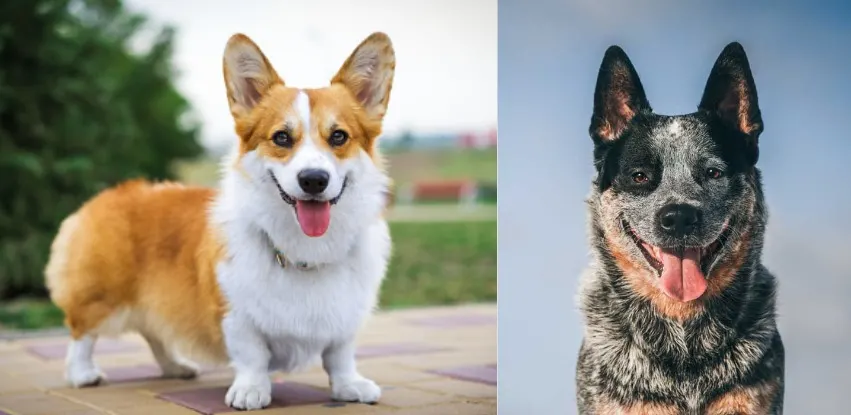What’s the first thing that comes to your mind when you read Cowboy Corgi? For me, it definitely wasn’t a crossbreed between the Pembroke Welsh Corgi with an Australian Cattle Dog. Now, I pictured an adorable Corgi in a cowboy suit. Something like this:
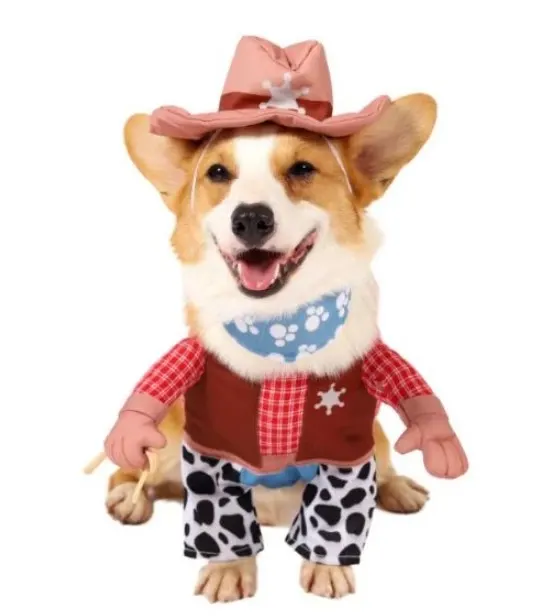
A Cowboy Corgi is not a Corgi in a costume
Precious, huh? But, that’s not what we’ll talk about in this article. I know, I’m just as disappointed as you are… In this article, we’ll learn more about the Corgi Blue Heeler mix or also known as the Cowboy Corgi. What do these dogs look like, what the difference between a Corgi and a Cowboy Corgi is, and if they would be a good pet for you?
What is a Cowboy Corgi?
The first question we need to answer is what a Cowboy Corgi exactly is. Well, to begin, the Cardigan Welsh Corgi and the Pembroke Welsh Corgi are the two Corgi variations that exist today.
The first has a tail, while the second does not, that is the fundamental distinction. Now, Cowboy Corgis aren‘t a new third variation, but a cross between Pembroke Corgis and Australian Cattle Dogs.
The Pembroke Corgi was developed primarily as a herding dog. Despite its diminutive stature, it is unafraid of cattle and performs admirably. Indeed, the lovely puppy will do it with glee.
Many people are surprised to learn that corgis can be so highly active, given their tiny legs and thick bodies. But it’s in their nature.
The Cowboy Corgi is a mixed breed that is not as short-legged as a corgi, but it is still on the shorter side of dogs. Despite that, they’re big, strong dogs with herding tendencies on both sides.
They’re the ideal working companion because they’re compact and can tag along and tuck away. They don’t eat much and have a pleasant personality to be around.
Cowboy Corgis are beautiful, intelligent dogs who would make a wonderful addition to any home. Their urge for a high-energy lifestyle, on the other hand, is something to consider.
Cowboy Corgi basic breed info
The Pembroke Welsh Corgi x Aussie Cattle Dog is becoming more and more popular. This is mainly because of their adorable looks and energetic personality.
As they are a product of a herding breed, these pups are high-energy dogs and it would be a good idea to bring them into an equally active family. They need lots of exercise, which helps them get rid of excess energy but also prevents weight gain. So if you don’t live a particularly active lifestyle, this isn’t the breed for you.
But, just like it is with every other crossbreed, they are not accepted by the American Kennel Club. With them being a mixed breed it also means there is a lot of controversy around them.
Many people are against mixed breeds, mostly because of sketchy breeders and because they are worried about the well-being of the dogs. Other people call hybrids a “glorified mutt”, which isn’t okay either.
So let’s take a quick look into the possible problems of owning any type of designer dog.
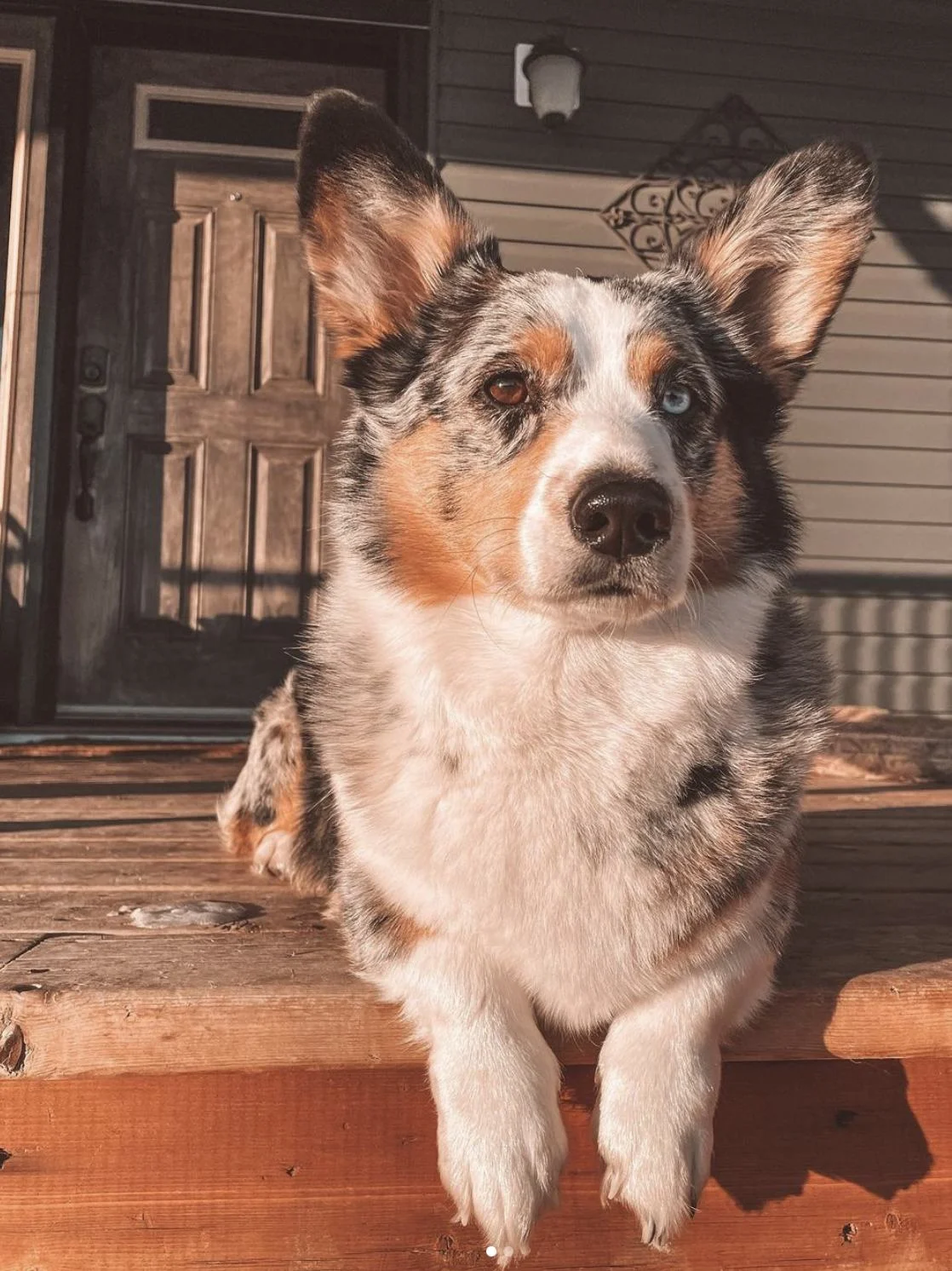
Source: Instagram (@d.pollitt9)
The problem with crossbreeds
The concept of mixed breeds or designer dogs as crossbreed enthusiasts like to call them sounds good in theory. Experts are combining two breeds, and the resulting breed will have the best characteristics of the parent breeds.
But, in reality, that’s not at all how it works. We can’t be sure that the mixed breed will have only the best characteristics of both parents. Of course, there are some things scientists can control.
This is also one of the reasons why many people call them “designer mutts”. Because at the end of the day, they are hybrids whose appearance and personality can‘t be fully predicted.
Uncertain results of designer dogs
Let’s take the Labradoodle as an example. Labradoodles are a mix between the Poodle and the Labrador. The idea was to get a dog that is low-shedding like the Poodle. But also a dog that has all the amazing characteristics of the Labrador, such as their temperament and personality.
Firstly, the issue with this is that Poodles come in three different sizes. So that’s the first characteristic you can’t control. You will not know how large the dog will be.
Secondly, you can’t know if your Labradoodle puppy will be more like one parent or the other. They might have more traits of the Poodle than the Labrador, and vice versa.
And lastly, a designer dog breed does not have the breed standard an already formed breed has. We want to stress one more time. Hybrid breed puppies can differ a lot based on the dominance of their parent breeds.
We are not saying that at some point all of these won’t be predictable. Breeders are working on perfecting the hybrid breeds. But in the end, it will likely take several years and decades until that happens.
Appearance
You know how it goes, when you mix two breeds there is no chance of knowing what the puppies will look like.
They can look like one parent breed or the other. Or they can look like an equal mix of both. But, we will give you general traits of this mix, so you can get an idea of what they might look like.
Cowboy Corgi size
Now you are probably wondering what the size of a full-grown Cowboy Corgi is. This mix is a small dog. They are usually from 13 to 20 inches tall and weigh between 26 and 40 pounds. But the Cowboy Corgi’s weight and size also depend on other factors, such as gender, age, health, and genetics.
| Size: | Between 13 and 20 inches |
| Weight: | Around 26 to 40 pounds |
| Temperament: | Highly energetic and loyal |
| Lifespan: | 12 – 15 years |
| Price: | Expensive for a hybrid, between $800 and $1,200 |
| Purpose: | Companion dog |
| Popularity: | Low, but increasing |
| Grooming: | Low, but they shed a lot, especially when blowing their undercoat |
| Hypoallergenic: | No |
There are two things that are for sure about this mix, they are thick and they have short legs. But, that doesn’t stop Cowboy Corgi puppies from being active.
These dogs have a short and dense double coat that is usually fawn and white. But they can also have three colors, black, fawn and white for example. They can also have spots like their Aussie parent. So, there is no rule to that.
Because of their double coat, they shed quite a bit. But, the shedding also gets worse once or two times a year when they are blowing their inner coat.
Another interesting fact about them is that they’re sometimes born without a tail. This is because of their Corgi parent.
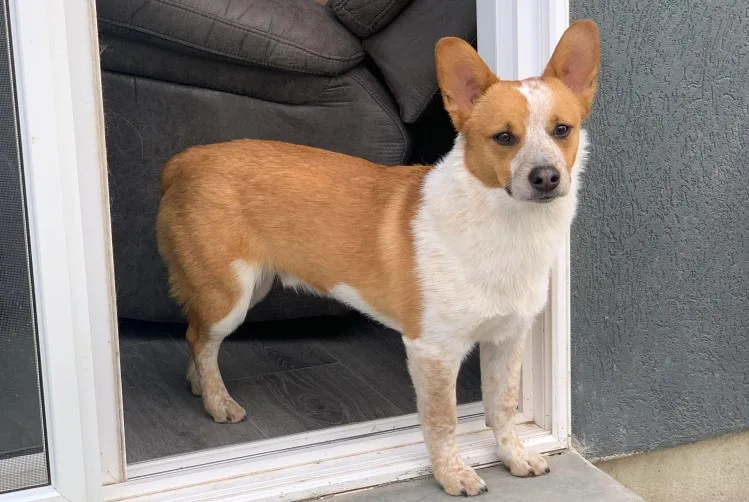
Corgis have a docked tail, so if their genes are more dominant, then the Cowboy Corgi won’t have a tail. But, that doesn’t take away from their charm.
Cowboy Corgi coat
A medium-length double coat is found in both of the two parent breeds of the Cowboy Corgi. It helps keep the dogs warm on cold winter days, but it also makes them shed a lot. In addition, Cowboy Corgis also have a dense double coat: an undercoat that can withstand the weather, and a coat that is a little longer on the outside.
Like their parents, Cowboy Corgis shed a lot of furs. In addition to that, they have periods where they completely lose their undercoat. That is called a “shedding season,” and it can happen once or twice a year. People who have allergies won’t like them because they shed so much. If you have allergies but want a dog, you should look for dog breeds that don’t shed a lot.
Then again, if you have to have a hybrid dog breed that doesn’t shed, you may look through this list of hypoallergenic dog breeds.
Most of the time, the coat colors of cowboy Corgis come from their Australian parents. Usually, they look a lot like Australian Cattle Dogs in terms of the colors and combinations of their coats. This breed is mostly known for having three different colors and patterns on its coat. They are also called tri-colored, sables, roans, or merles. Even though they don’t have merles, they will look more like Corgis if they don’t have any at all.
How big do Cowboy Corgis get?
As we already discussed, these adorable puppies don’t get too big at all. A full-grown Cowboy Corgi is a rather small dog in the great scheme of things. The Cowboy Corgi’s weight ranges from 26 to 40 pounds, and their height ranges from 13 to 20 inches.
Basically, they’re small, cute dogs with short legs. They have the standard short stature of a Corgi with the same adorable features. There is even a mini Cowboy Corgi available that weighs between 24 and 26 pounds.
When we compare a Cowboy Corgi VS Corgi, their bodies are a little bulkier. But that doesn’t stop them from being very active. They have the activity levels of a large breed, only in a smaller package.
Even though they are so small, they aren’t exactly ideal for an apartment. These are herding dogs that need to be active, so a smaller house with a huge backyard would be ideal for them. They are a great addition to an active family living in a rural area looking for a family pet.
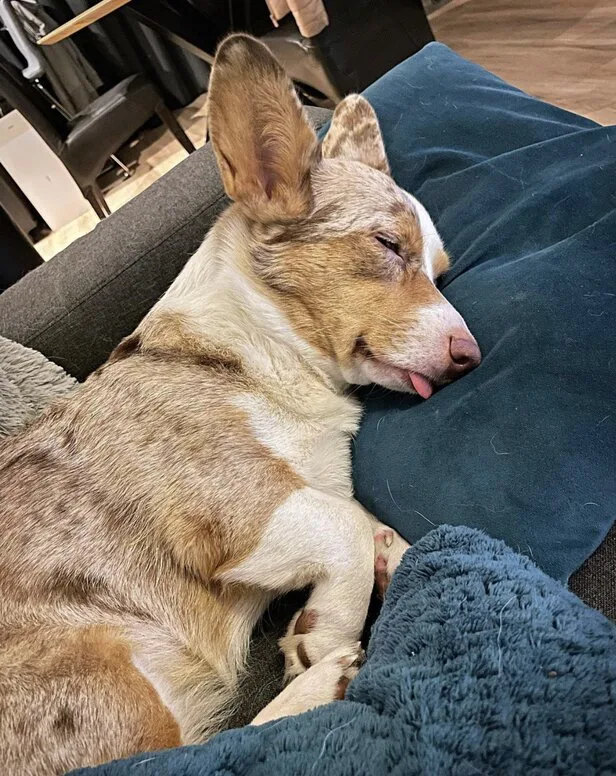
Personality of the Cowboy Corgi
There is a lot to say about the Cowboy Corgi and their personality. Even though this is a small dog, they are mighty and they might surprise you with some traits and actions.
The best way to explain the personality of a Cowboy Corgi is probably by answering some of the frequently asked questions about this hybrid.
Are they good family dogs?
Cowboy Corgis are an excellent addition to any busy household, no matter how large or tiny. They have the stamina to keep up with the kids in the yard or explore the great outdoors with their “pack.”
It’s important to remember, though, that educating your children on how to play with the family dog is necessary. Following safety requirements when it comes to children and pets is very important (especially when young children are involved).
Cowboy corgis, on the other hand, can be wonderful, family-friendly dogs who get along well with youngsters. They can even thrive in a family with only adults. A cowboy corgi is a happy dog as long as it can enjoy some fresh air with its favorite folks.
Are Corgis good with kids?
Generally speaking, Cowboy Corgis, just as purebred Corgis, are good with children. But, you need to remember that this is a Pembroke Corgi x Australian Cattle Dog mix, both of which have very strong herding tendencies.
That is not a bad trait at all. Some people are exclusively looking for that trait when picking a breed for themselves, but when kids come into the equation you need to be careful.
As mentioned, Cowboy Corgis, like both of their parents, have strong instincts to herd, so they often try to herd children, slow-moving adults, and other pets in the house by biting them.
But, don’t worry, this herding behavior can be stopped with early socialization and proper training. Early socialization is important with any breed. You’ll get a well-rounded and well-behaved dog by exposing your dog to other people, places, and animals.
Are Corgis aggressive?
The next question about Cowboy Corgi‘s temperament we need to answer is if they are aggressive. A well trained that was socialized from puppyhood will not be aggressive towards anyone or anything. But, if that is not the case, they do tend to show aggressiveness towards strangers and other animals.
This is not the dog‘s fault, though. This aggressiveness shines through in moments when they feel threatened, or when they think their pack, or in this case, family, is being threatened by someone or something.
So, the short answer to the question if Cowboy Corgis are aggressive is that they can be but under certain circumstances and if they are not trained and socialized well.
Are Corgis hyper?
Cowboy Corgis have a lot of energy! You will have to take them on long walks, runs, and you can even take them with you on hikes. Both its parents are used to working outside for long hours, so it‘s not surprising that the Cowboy Corgi is tireless as well.
We read somewhere that the Cowboy Corgi’s nature is just like any other dog’s, but if they were on steroids. And that’s probably the best description of them.
This mix is small, but they are full of energy. They love to be outside and run around and generally move a lot. If they don’t get the physical activity they need, they’ll go crazy! And your furniture might suffer.
That’s why they might not be the perfect apartment dog. They simply need their freedom and a way to get rid of all that energy inside of them.
Even though they are small dogs they have a lot of endurance. So, feel free to take them on long walks, runs, or even hikes. No activity is too demanding for them.
How smart are Corgis?
Another very reasonable question to ask before getting any breed of dog is how smart they are. So, how smart are Cowboy Corgis? If you are interested in this mixed breed is that they aren‘t only high energy dogs, but also a high-intelligence mix.
Cowboy Corgis will amaze you with how smart they really are! But it‘s no surprise, given that both its parents are very intelligent breeds. So, it will be a piece of cake for them to learn new tricks and commands. That is if they want to cooperate.
Cowboy Corgis are as equally stubborn as they are smart. So, even though they can easily learn anything, it doesn‘t mean that they want to. We don‘t want to discourage you, this is an obstacle that can be managed without any big problems. It is just important to start obedience training early on. Another tip we have for you is to stay firm when training them and be patient.
Do Corgis bark?
It’s important to know that this dog’s loyalty can’t be measured. It’s one of the traits they are known for. Which is another reason why you have to socialize them well. If you don’t do that, they will see any unknown person or animal as a threat and will try and protect you. Even if there is no danger.
But, even though they are so loyal, if you socialize them properly, they don’t bark a lot. So, don’t worry about the whole neighborhood hating you because of your dog’s barking.
Can a Corgi be left alone?
We have already said that a Cowboy Corgi is a very loyal dog, and because of this, it is not advised to leave them alone for an extended period of time. It is best that someone is always with them. Otherwise, they might turn to destructive behavior like barking, biting, or chewing on your furniture.
But, obviously, you can train your dog to stay alone for a couple of hours, and that won‘t be a problem, just don‘t leave them alone for 10+ hours every day.
Cowboy Corgi Health Problems
Many mixed breeds are usually healthier than their purebred parents. This is because breeders purposely try to eliminate all hereditary health conditions.
But, that doesn’t mean this dog isn’t susceptible to certain health problems. Just like any dog, there is a chance of them getting sick.
- Hip dysplasia – The number one health problem among dogs. Both of its parent breeds can have this condition. So, the Cowboy Corgi can get it too. It’s an abnormal formation of the hip socket, it happens when where the “ball and socket” joint of the hip does not properly form while they’re still puppies.
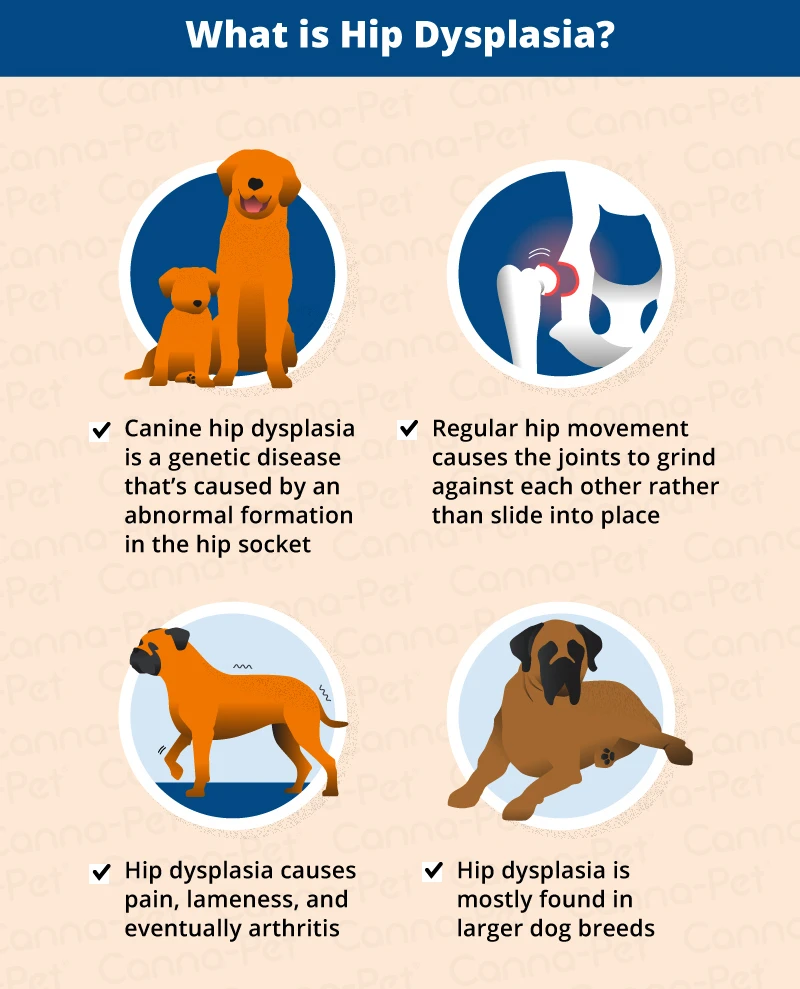
- Progressive Retinal Atrophy or PRA – Atrophy means partial or complete wasting of a body part. In this case the dog’s eyes. PRA is actually a group of degenerative diseases that affect the photoreceptor cells in your dog’s eyes. Basically, the cells die away over time, eventually leading to blindness.
- Deafness – The Australian Cattle dog is known for being prone to hereditary deafness. Sadly, if this happens there is no way to treat it. And there isn’t much you can do to prevent it either.
- Slipped disk – Common among Corgis. It’s when a disc in your dog’s spine is ruptured or herniated, leaking its contents and causing severe inflammation and pain. It affects dogs with short legs and it can start when your dog is just three years old. You can help your dog and prevent this condition by feeding your dog a balanced diet and keeping them at normal weight. Obesity increases the chance of this problem.
Thankfully, most of them are still healthy dogs. The average Cowboy Corgi lifespan is between 12 to 14 years.
Other common health issues
Patellar luxation
Patellar luxation, or the dislocation of the kneecap, is common in these dogs. The kneecap usually sits in front of the hind leg’s joint and is maintained in place by ligaments. It moves around in a groove when the dog walks, protecting the joint but allowing the dog to move freely.
This little bone can dislocate and slip out of the groove in certain dogs. So it’s causing it to “float” freely about the knee. If left untreated, this can lead to major complications. It’s possible that the bone will be forced up against another bone, causing damage. Ligaments are frequently injured when the kneecap moves around incorrectly.
Allergies
Allergies to pollen, mold, and dust cause people to sneeze. Instead of sneezing, allergies in dogs produce itching. Atopy is a name used to describe a common skin allergy in these puppies. The most commonly affected locations are the feet, tummy, skin wrinkles, and ears. Symptoms normally emerge between the ages of one and three, and they can get worse as time goes on. Licking the paws, stroking the face, and recurring ear infections are the most prevalent allergy symptoms. The good news is that these diseases can be treated in a number of different ways.
Epilepsy
Unfortunately, dogs too can develop epilepsy and seizures. Recurrent seizures with no known cause or abnormal brain damage characterize epilepsy. To put it another way, the brain appears normal on the outside but functions strangely on the inside. Twitching, shaking, tremors, convulsions, and/or spasms are all symptoms of a seizure.
Cataracts
In older canines, cataracts are a common cause of blindness. The lenses of his eyes become more opaque—in other words, hazy rather than clear. Many dogs adapt well to losing their vision and live happily ever after. Surgical removal of cataracts and restoration of vision may also be a possibility.
Von Willebrand’s Disease
This is one of the most prevalent blood clotting problems in humans, and you might be surprised to learn that it can also affect your dog. Von Willebrand’s disease is caused by a lack of the von Willebrand Factor, a protein that aids in blood clotting.
In the event of even a minor cut, this can result in significant bleeding. This disease is difficult to detect because your dog may appear to be in perfect health for their whole life unless they have an injury. Other signs and symptoms may appear in some dogs. Nosebleeds, blood in the feces or urine, and easily damaged skin are examples.
If you and your dog are both careful, this ailment will not have a significant impact on your dog’s quality of life. Inquire with your veterinarian about treatment options for the condition. It’s critical to have your puppy checked for this problem as soon as possible, as certain medications, such as aspirin, might make it worse.
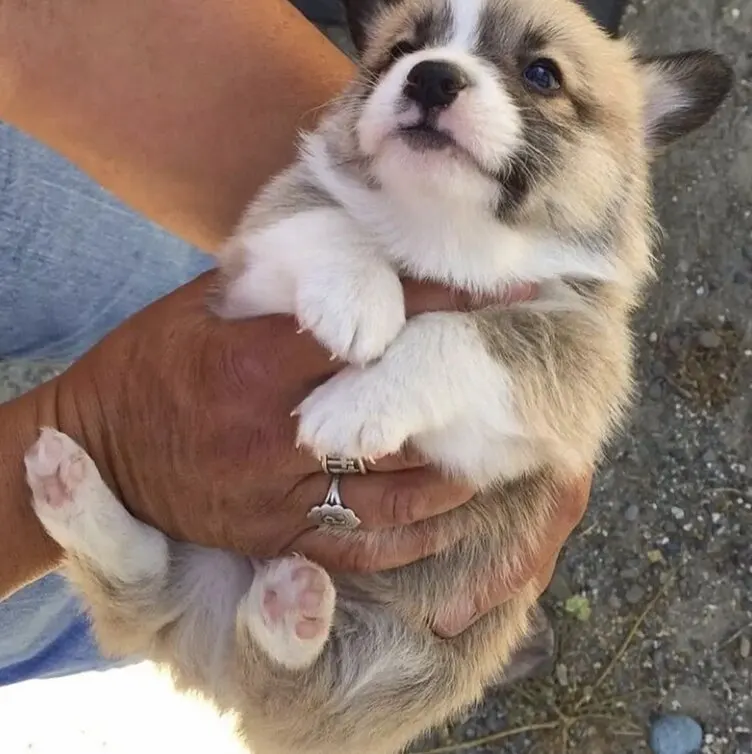
Caring for Cowboy Corgi puppies
Taking good care of your dog and feeding them a nourishing diet filled with nutrients is key in keeping them healthy. Also, take your dog to the vet regularly for check-ups. This way you can make sure you’ll spot health problems early on.
Another important part of keeping your dog healthy is taking care of its fur, basically grooming. We suggest you brush your dog daily, especially during the periods when they’re blowing their coat. Take them to the groomers for a trim regularly, and make sure to clip their nails. It’s also important to brush your dog’s teeth every day, or every other day.
You can find out more about canine dental care in our other articles, try using the search field with these questions:
- How to clean dog teeth without brushing?
- How To Brush Dog’s Teeth: Step-By-Step Guide
- Dog Broken Tooth — Fractured Teeth
- Dental Problems In Dogs: Keeping Teeth Healthy & Clean
- Do dogs really need dental care or do they keep their teeth clean by chewing?
Regular exercise is a must too. We’ve already said that they are active dogs. This means they need at least one hour of exercise every day. They also need mental stimulation. The best way to get both is to play fetch with them or Frisbee. Training can be another great way for them to get the physical and mental exercise they need.
Grooming
If you’re thinking about getting a Cowboy Corgi, bear in mind that they demand a lot of grooming. They have a double coat and shed a lot. That requires regular grooming—around 20 minutes of coat brushing every day.
You can control the amount of shedding by brushing their coat on a frequent basis. We recommend using a smooth brush to ensure that all of the loose hair, dirt, and burrs are removed.
While Corgi Cattle Dogs require lots of brushing, they only need to be bathed once or twice a month. But of course, if your Corgi Cowboy gets in something smelly and nasty, bathe him to remove all of the dirt.
While washing him, make sure you are using a vet-approved dog shampoo. Regular shampoos could dry out their skin. But we have some good news when it comes to bathing your Cowboy Corgi — they enjoy being in the water! So this process should be a piece of cake.
Using a warm moist towel or cotton ball, clean your dog‘s ears once a week. Your veterinarian can advise you on which ear cleaning solution is best for your dog.
Your dog’s nails should also be trimmed. Use a dog-specific nail clipper and take special care not to cut too deeply into the skin or blood vessels.
To make things easier, you can have it done by your veterinarian or a professional groomer. Brush your dog’s teeth at least twice a week.
Do they shed a lot?
Cowboy Corgis are not hypoallergenic, thus they can shed excessively at times. This is due to the fact that both of their parents, the Australian Cattle and the Pembroke Welsh Corgi, have double coats that shed heavily.
They also have shedding seasons, which happen once or twice a year and cause the undercoat to shed more regularly. Bathing and brushing your dog on a regular basis can help to reduce shedding around the house. If you have a history of pet allergies, you should avoid this breed at all costs—nothing is worth putting your health at risk for.
But even if you have some dog allergies, that doesn’t mean that you can’t have any other dog in your home. Instead of a Cowboy Corgi, you could consider hypoallergenic dog mixes or non-shedding pets. People with allergies can easily get along with these dogs if they are properly cared for.
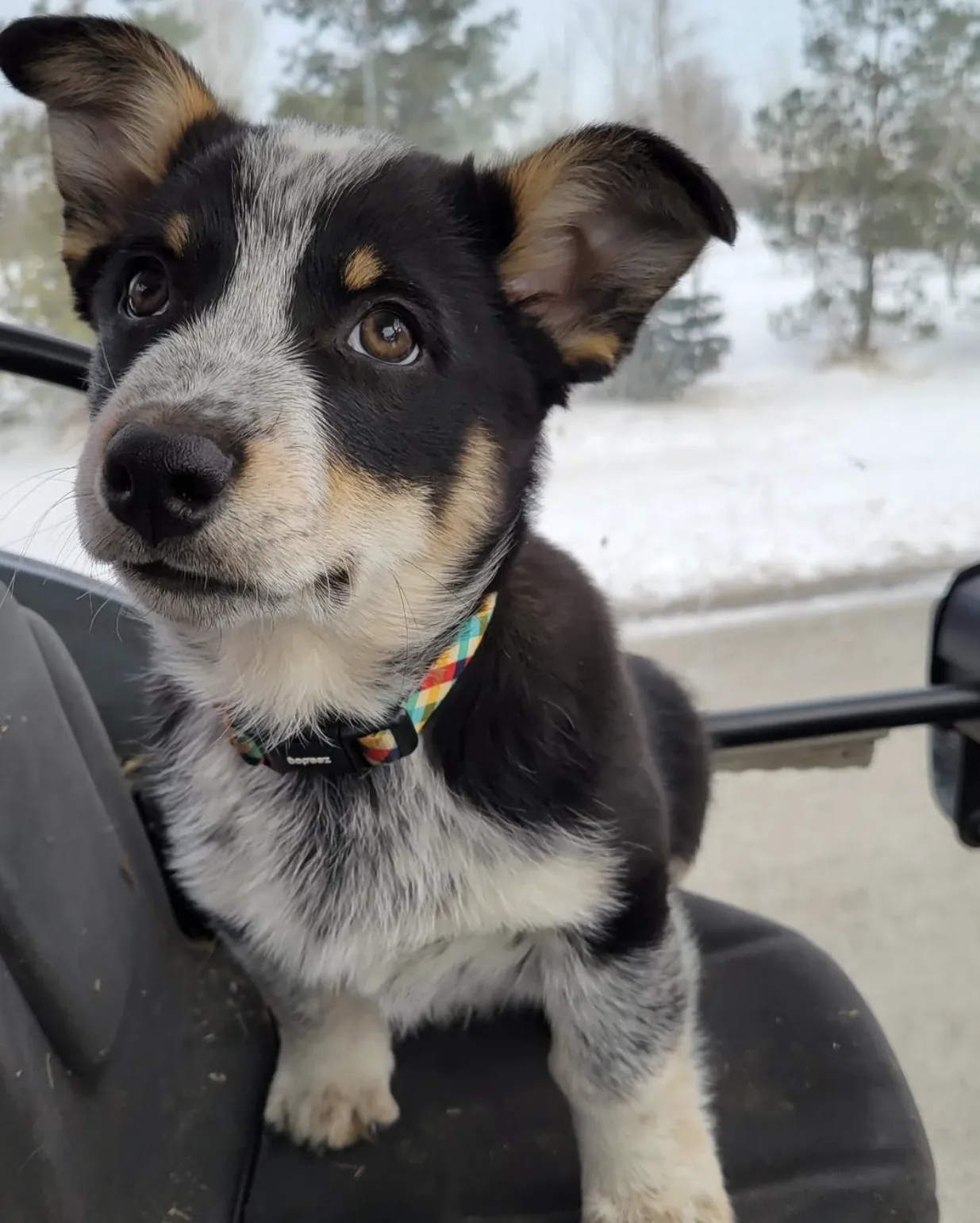
Source: Instagram (@lincfarm)
Exercise
Cowboy Corgis are highly energetic dogs who require a lot of activity to preserve their health, despite their small to medium size and stubby legs. You can’t blame your Cowboy Corgi for behaving aggressively and destructively if you don’t provide them with enough exercise.
You can take your Cowboy Corgi for walks in the morning and evening. Furthermore, if you’re going trekking or swimming on the weekends, bring your Corgi along—they love new experiences. But, you should not limit their activity to just walks and weekend excursions.
For mental stimulation you can assign other chores to your Corgi at home—they enjoy working and pleasing their owners. This will keep their minds occupied. We recommend that you do not get a Cowboy Corgi if you are unable to care for their exercise needs. Instead, consider looking into some of the lazier dog breeds, which don’t require much activity and are ideal for working dog owners.
Food & diet
Cowboy Corgis have more dietary and nutritional needs than other small or medium-sized dogs. They are very active dogs who use up a lot of energy during the day. As a result, they need more food than many other dog breeds of the same size.
The calories that Cowboy Corgis eat should be equal to the amount of energy they use during the day. If your Corgi doesn’t get enough exercise and eats a lot of calories, he will gain weight and become chunky. So make sure that you pay attention to how many calories they eat.
For the most part, these dogs thrive on high-protein foods that will let them do their exercise and give them enough energy for all the running around. Carbohydrates and fats, which are also good sources of energy for the body, are also good.
The protein in your dog’s food should make up about a quarter of his or her food. You can also feed him meat such as chicken, turkey, fish, and beef which is also very rich in protein. But it’s not only meat that is protein-rich. Beans and other vegetables can be a great source of protein as well. And lastly, make sure your Cowboy Corgi is getting all of the vitamins he or she needs to stay healthy.
Training
It is simple to train Corgi Cowboys since they are incredibly intelligent. You may quickly teach them not just the basic obedience instructions, but also advanced abilities like how to roll over, and using proper reinforcement dog training strategies.
Advanced training will not only improve your dog’s skills but will also offer them enough cerebral stimulation to keep them healthy.
You can simply teach your Cowboy Corgi how to walk on a leash, crate-train him, and offer him guard dog training with just a few treats.
Cowboy Corgis have strong herding instincts, therefore if they aren’t socialized, they may nip at your little children, elderly people, or other pets. As a result, you must begin socializing training for them at a young age.
Training sessions that are shorter but more frequent are more effective than ones that are longer but less frequent. Training sessions should be kept to a maximum of 10 to 15 minutes.
The key to Cowboy Corgi training is to begin while they are young and to be consistent. Punishing your dog for bad behavior is unproductive, so only employ positive reinforcement tactics.
That being said, you should not promote bad behavior—the best course of action is to simply ignore it and not pay attention to it.
Why is my Corgi so hard to potty train?
One issue many Cowboy Corgi owners often face is potty training. But, this is the case with almost all puppies. Potty training is not easy and it takes a lot of work and needs time.
It can take a long time to train your puppy to go to the bathroom outside. Some dogs still mark their territory and go to the bathroom in the house even after years of training and positive reinforcement.
The best routine to follow when potty training your dog is:
- Take your puppy outside often
- Practice positive reinforcement
- Stick to a feeding schedule
- Recognize when your dog needs to go out.
Before you buy a Cowboy Corgi puppy
Cowboy Corgi puppies are the outcome of a crossbreeding of Pembroke Corgis and Australian Cattle Dogs, as previously mentioned. There are a lot of similarities between Cowboy Corgi puppies and Corgis, the most obvious being that both have short legs. However, they inherited some traits from their Cattle Dog parent, such as the coat color. These Corgi Cattle puppies are adorable and much sought after by fans of designer dog breeds.
Cowboy Corgi puppies are exuberant and active at first, but they grow into calm, content adults soon. They’ll play with anyone if you encourage them, but they’ll also be satisfied just to be by your side. If you’re thinking about getting a Cowboy Corgi puppy, there are a few things to consider first.
Because Cowboy Corgis are little, their owners frequently over-indulge them, causing them to misbehave and always get their way. Small dog syndrome develops in Cowboy Corgi puppies, and the puppy grows up to be a quite difficult adult dog. So, while you should love and adore your dog, you should never appreciate their wrongdoing.
Cowboy Corgis, like both of their parents, have strong herding instincts, and they frequently bite at children, elderly people, and other pets in the house in an attempt to herd them. Early socialization and behavioral training can help to reduce this herding propensity.
You should begin socializing and training your Cowboy Corgi puppy at a young age if you want them to grow up to be a well-behaved adult dog. They can grow up to be sociable and affectionate family dogs if they are properly trained.
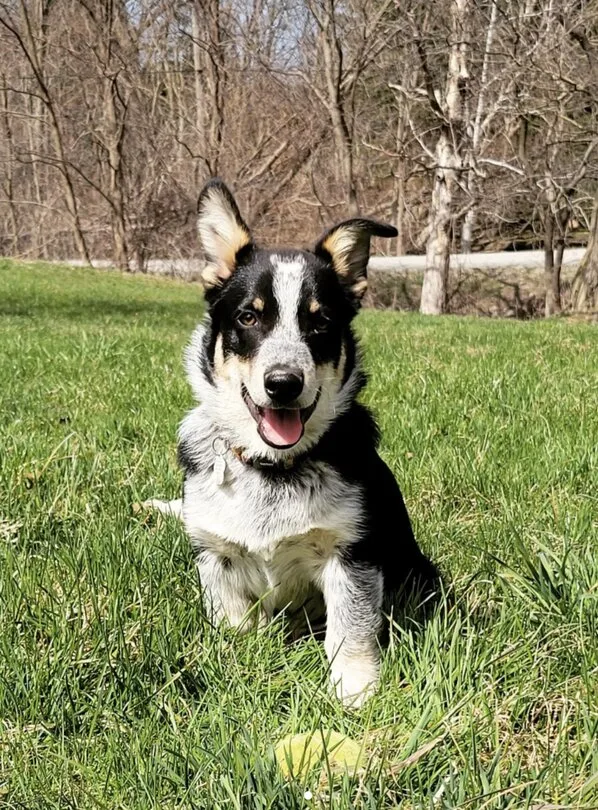
Price of a Cowboy Corgi puppy
Designer dog breeds have a wide range of prices. Because major kennel clubs and organizations do not accept them, you might expect them to be less expensive than pedigreed pets. Designer dogs, on the other hand, can be just as expensive as pure breeds due to their popularity. The Cowboy Corgi is an example of this.
These adorable puppies are priced similarly to their parents. Corgis and Cattle Dogs typically sell for $500-$1500, depending on the stock quality and the breeder’s care. Corgi Cattle Dogs are priced similarly to their parent breeds, following pricing influences from both.
However, if you’re willing to spend some time looking through local shelters and the internet, you might be able to find one of these gorgeous puppies available for adoption. You’ll not only save money, but you’ll also be assisting a Cowboy Corgi in leaving the shelter and coming to live with you.
Do Kennel Clubs recognize Cowboy Corgis?
Cowboy Corgis are not recognized by leading kennel groups such as the AKC, CKC, or UKC because they are a mixed breed. If you want your dog to be registered, contact the Designer Breed Registry (DBR), which was founded in 1979 to encourage the development of mixed-breed dogs.
You can also enroll your Cowboy Corgi in the AKC’s Canine Partners Program, which has been in effect since 2009. Despite the fact that your dog will not be recognized by the AKC, it can still compete in separate activities like AKC rallies, obedience, and agility.
Are Cowboy Corgis rare?
Corgis are not as uncommon as other mixed breeds. Many dog breeders specialize in developing this breed, so you should have no trouble finding one.
Even though backyard breeders and puppy mills create the majority of Cowboy Corgis, we would still advise you to avoid doing business with them.
Puppies from these breeders were grown in deplorable conditions, with numerous birth defects and serious health problems.
Where to find one?
If you’re wondering where you can get a cowboy corgi, you have a lot of choices.
You might be able to discover a cowboy corgi at a rescue. Because they’re a mixed breed that looks much like corgis, you’ll most likely find a cowboy corgi for adoption at a corgi rescue. You might also try checking into local shelters.
If you decide to buy a cowboy corgi puppy from a breeder, do your homework first. Because they’re such a popular breed, the risk of unknowingly purchasing one from a puppy mill is higher.
Do your homework and thoroughly research any potential breeders. Examine their website thoroughly, speak with prior customers, and, if possible, pay a visit to the breeder and see the parents of your potential puppy. Taking these precautions can also help you avoid puppy fraud on the internet.
A cowboy corgi can undoubtedly be a wonderful addition to your home. They’ll provide you with a lot of love, fun, and a terrific companion on all of life’s adventures, no matter how you welcome one into your family.
How cold is too cold for Corgis?
Cowboy Corgis can surely journey through the snow on occasion, but you shouldn’t allow them out if the temperature is dangerously low.
Cowboy Corgis enjoy the cold weather and can tolerate temperatures that are lower than 50 degrees Fahrenheit; but even so, they may experience slight discomfort.
As a rule of thumb, anything around 35, 40 °F for more than 25 minutes, 30 minutes at the most, is acceptable. Lower temperatures, on the other hand, do require extra equipment.
Every dog, regardless of age or breed, needs to spend their time indoors. Though Cowboy Corgis have a lot of energy and are known to make “puppy eyes” when they want something, it’s best to keep them indoors during a heavy snowfall so they can gallop up and down the stairs.
Conclusion
To conclude, the Cowboy Corgi is a great dog with amazing traits. But they are not for everyone. Even though they are small, they still need just as much exercise as a German Shepherd or any other large breed.
This means they need an active family. People who love hikes and jogs, and basically any other physical activity.
It isn’t a must for them to live in a big home with a yard, but it would make it easier for the owners. If they can go out and run around in the yard whenever they want, then you won’t have to take them out so much.
But, if you live in a flat and still want this mix, just make sure they get enough exercise. Take them out a couple of times a day. Take them to the park, play with them and let them run around with other dogs.
Even though Cowboy Corgis are affectionate and caring, they can be aggressive towards cats and dogs with which they are unfamiliar. If you already have pets at home and want to have a Coyboy Corgi, you may face difficulties. But don’t worry, with proper socialization and training, your cat and dog can live together happily as best friends.
Are you the proud owner of a Cowboy Corgi? Tell us in the comments about your experience with this magnificent crossbreed.

